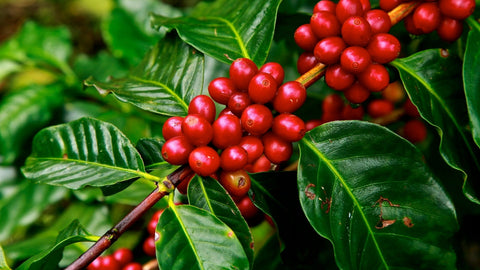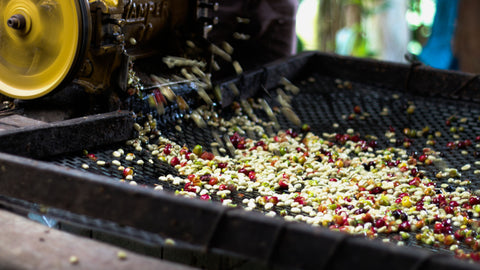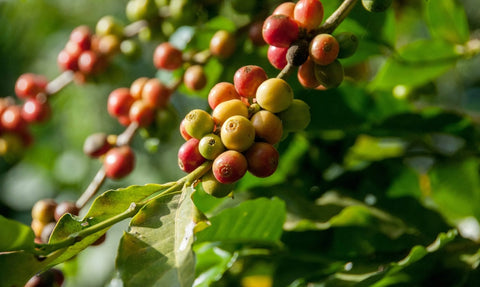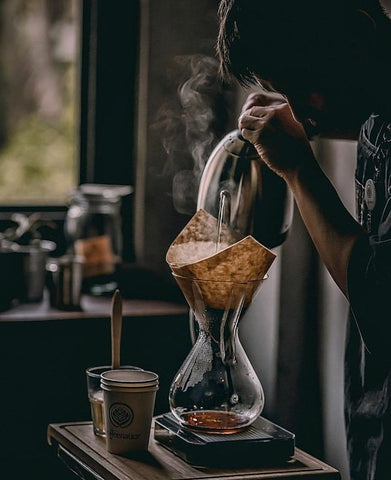My shopping cart
Your cart is currently empty.
Continue ShoppingCoffee comes from a plant! Coffee plants are woody evergreens that can grow up to 10 meters tall when growing in the wild. So the roasted coffee bean that was brewed to make your favourite drink this morning, is indeed the seed from a berry.

Single origin coffee is coffee that has come from a single source that gives focus to one distinct area or geographical region where the coffee is grown. This is a great way to experience different coffee from each region. We have various Single origin coffee for you to try from Colombia, Guatamela, Costa Rica, Peru, Ethiopia, Bali etc.

Blends are coffee that have come from two or more sources and have been mixed together to create a particular flavour profile. Blends are generally more rounded with their characteristics and provide a better consistency over time in the flavour profile, as opposed to single origin coffees as the seasonal changes in each crop will not affect the overall flavour when it is blended with several other coffees. Blends generally tolerate milk a little better than single origin coffees and black coffee is usually the best way to experience the differences in single origin coffee. Have you tried our Blends?
Processing is simply the way the producer removes the soft layers of fruit from the coffee cherries to remove the seeds known as the ‘coffee beans’. This process, more than any other factor, will impact the flavour you get in the cup. As a result, it is the single biggest flavour decision on a bag of coffee, particularly if you’re choosing a Single Origin Coffee.
There are many subtle variations in processing around the world, but they can be broadly grouped into 2 categories: Washed & Natural.
Basically, the washed process will deliver coffee with a clean, transparent profile which allows varietal and origin (terroir in wine parlance) flavours to dominate. The natural (or dry process) will tend to add a dense layer of ripe fruit sweetness- sometimes complex and nuanced, sometimes cloying and oversweet. It may or may not overpower the inherent characteristics of a coffee.

There are many variations on each method, as well as techniques in between the two, and it is a good idea to get familiar with them as you make your first big flavour decision.
You can’t really have a conversation about origin without talking about variety. Most people have heard of the 2 most common species of coffee: Arabica & Robusta.
Arabica:
Grown at altitudes above 800m
Higher quality
Mild well balanced flavour
Naturally lower in caffeine
More expensive
Larger Beans Size
Well rounded, mild and pleasant aroma
Just like wine or apples, the Arabica species of coffee exists as a wide array of varieties, and like wine, varieties are usually planted in a particular location due to their suitability to the environment. When people talk about specific coffee origins – like Ethiopia or Colombia, they will often remark on a particular flavour profile. These flavours are largely due to the types of coffee varieties found there. Kenya for example is famous for the SL28 and SL34 varieties which were developed by Scott Laboratories mid last century for their yield as well as their intriguing blackcurrant and winey flavours. Ethiopia, being the home of coffee, proliferates with indigenous ‘heirloom’ varieties, mostly uncategorised. Their tropical fruit and citric flavours are prized the world over. Brazil generally produces and is known for chocolatey, nutty flavours from their huge estates, a result of altitude, variety and cultivation.

In addition, you will find nuances in the same varieties between different countries and region as local conditions transform the flavours over decades. Becoming familiar with inherent flavours of different origins will educate you to an important flavour decision.
Robusta:
Grown at altitudes lower than 800m
Commonly used in instant coffee
More astringent and bitter in flavour
2x the amount of caffeine
Given that there are over a hundred species of coffee, Robusta has done well to become the second most popular coffee on the world market. Robusta coffee is a type of coffee made from the beans (seeds) of the Coffea canephora plant.
Robusta originated in central and western sub-Saharan Africa. It is the second most popular coffee in the world, making up 40% of the world’s coffee production.

It comes second only to arabica (from the Coffea arabica plant) which makes up the remaining 60% (or more) of coffee production worldwide.
Most people in the world would have had Arabica coffee.
Every roaster will have a different interpretation of any given coffee. One might see the potential in a coffee for a lightly roasted, elegant profile, while another may see the opportunity to roast a bit darker for a more intense, chocolatey flavour. Amazingly this same coffee will taste completely different in each case! This element of selecting a coffee to buy is a little more mysterious
How we know to what degree a coffee has been roasted? Does dark roast mean the same thing to every roaster, let alone every consumer? Given that these are relative values, it pays to understand that this factor may be influencing your choice in coffee without you realising it. To know that the same coffee roasted by two different roasters may taste vastly different is to acknowledge a decision made by the roaster- you can then make your own informed decision from roaster to roaster.

The brew method you use makes this a very important decision as most roast profiles are aimed broadly at a style of brewing. If you have an espresso machine at home, you most likely will need a darker and richer roast, whereas if you brew with a drip filter, a more delicate and lighter roast will probably (but not necessarily) be ideal. Fortunately, this information is often denoted as a “filter” roast or “espresso” roast on the bag itself. However, there is nothing wrong with using an espresso style roast in your drip filter, just as some may like an espresso made on a lighter and brighter roast.
As always with flavour, nuance and preference apply, but to understand the methodology of roasting will make your choices easier.
These considerations are the variables that make coffee so interesting and fun! There are so many flavour options out there these days as producers get more experimental, roasters explore their craft and brewers try new methods.

So, it is valuable to be armed with enough information to be able to make thoughtful decisions about your next purchase, whether it is for your morning brew at home or your next feature coffee in your cafe or bar.
Happy brewing!
There are many interesting and lesser-known facts about coffee! Here are a few:
Coffee beans are actually the seeds of a fruit: Coffee beans are often referred to as beans, but they are actually the seeds of the coffee plant's fruit, called a coffee cherry.
Coffee was originally eaten, not drunk: The first recorded use of coffee was in Ethiopia in the 9th century, where the beans were ground up and mixed with animal fat to create a snack.
Coffee is the world's second most traded commodity after oil: Coffee is a major global commodity, with an estimated 25 million people worldwide involved in coffee production and trade.
Coffee can be good for your skin: Coffee grounds can be used as a natural exfoliant and can help to reduce the appearance of cellulite and brighten the skin.
Finland is the world's biggest consumer of coffee: According to data from the International Coffee Organization, Finland consumes the most coffee per capita in the world, followed by Norway and Iceland.
Decaf coffee is not 100% caffeine-free: Even decaf coffee still contains a small amount of caffeine. The decaffeination process removes most of the caffeine, but not all of it.
Coffee was once banned in Mecca: In the 16th century, coffee was banned in Mecca because it was thought to stimulate radical thinking.
The word "coffee" comes from Arabic: The word "coffee" comes from the Arabic word "qahwah," which means "wine of the bean."
Coffee can be used as a natural dye: Coffee has been used as a natural dye for fabrics and paper. It can create shades of brown, tan, and even black.
The first webcam was invented to monitor a coffee pot: In 1991, a group of computer scientists at the University of Cambridge invented the first webcam to monitor the status of a coffee pot. The webcam allowed them to see when the coffee was ready without leaving their desks.
These are just a few of the many interesting facts about coffee!